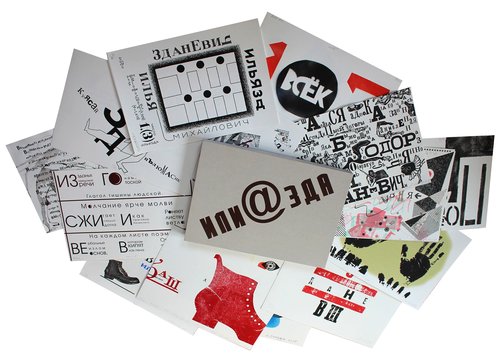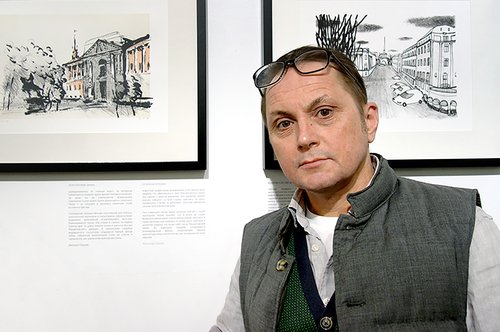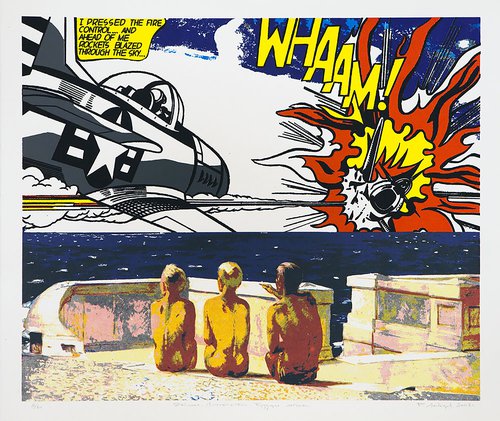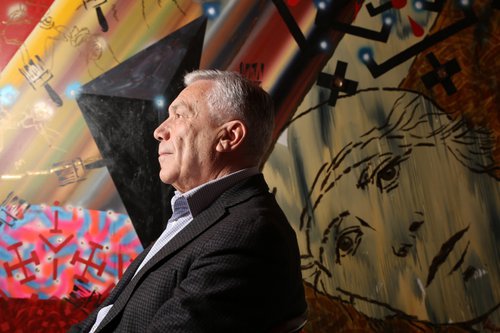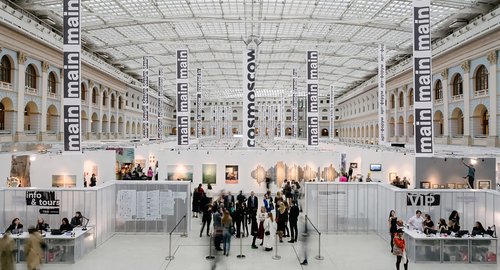Alexei Veselovsky at his exhibition. A Tower. History of Observations. Solo Exhibition of Alexei Veselovsky. Courtesy of PiranesiLAB
Veselovsky, the Prince of Prints
Russian artist and printmaker Alexei Veselovsky has opened a solo exhibition at Fabrika in Moscow, the culmination of three decades of his philosophical reflections and a monument to his passion for printmaking, which even a fire itself could not extinguish.
I meet Alexei Veselovsky (b. 1969) in his workshop, an industrial style space with dizzyingly high ceilings, where he is perched at his desk commanding from the mezzanine above. The space is overflowing with art both his own and that of other artists. Here stars of the Russian and international contemporary art scene such as Igor Makarevich (b. 1943), Aidan Salakhova (b. 1964), Olga Chernysheva (b. 1962), Boris Orlov (b. 1941), and MishMash duo work on art projects which involve printing techniques. It is called Piranesi LAB, and the name is apt because the layout of this multi-level open space, with its maze of floors and stairs, immediately evokes the architectural fantasies of this Italian artist. The workshop itself is hidden in a maze of stairs and endless corridors in Fabrika, a now defunct paper factory in Moscow. Its owners turned it into a cultural centre with offices for rent, exhibition spaces and artist studios.
Veselovsky's solo exhibition ‘A Tower. History of Observations’ is tucked away in another wing of the factory complex. But there is no such separation in his life: Veselovsky’s business and art practice are closely intertwined."They are two halves of myself," he explains."One half works with other artists where I act as their mentor, as a guide into the world of printmaking. The other half is dedicated to a traditional art practice mainly painting, installation, and ceramics as well as of course works on paper". A favourite medium of his is photo-watercolour, a complex technique based on a photographic process invented by pioneer Henri Fox Talbot (1800-1877). Printed on watercolour paper, these images have a dreamlike, painterly quality.
He was fascinated by printmaking from an early age. "I became interested in the process of making art, where an image does not appear directly from my hand, but in a single moment from a matrix – with printmaking there is always an intermediary between artist and image whether a sheet of metal, a stone, a wooden board or digital file," he reflects. For him, printmaking is "not just a medium, but a kind of artistic vision". He studied the technique of printmaking at the Moscow State Academic Art Institute named after Surikov and at the Tamarind Institute in Albuquerque, New Mexico – a workshop that has been training printmakers for over six decades. Veselovsky dreamt of creating something similar in Russia and it took him many years, finally founding Piranesi LAB in 2015. "For the first few months I sat on my own here, trying to figure out what to do next. I had a vision in my head, but I didn't know how to bring it to life." He started with open studios, workshops and masterclasses to build a community of people who shared his passion for artisanal printing. The strategy has worked so well that, with a staff of eight, there is no room for training in the lab anymore – the shop is too busy working on institutional commissions and artist collaborations. When an artist comes here with a project in mind, he or she and Piranesi LAB work as co-publishers, sharing the production costs and profits from the sale of the artworks. Veselovsky chooses his collaborators with great care. "I study what they do, how they work and how they think. It's like love, there has to be a certain human connection, otherwise it doesn't work," he explains. "It is very important for an artist to find out why he or she wants to make edition prints. They should explain that to themselves first. It is not just a way of reproducing a work, it is not about endless copying – there has to be a concept behind it".
According to Veselovsky, Piranesi LAB is “a printing studio focused on collaborative printing, producing limited edition artist prints.” A few years ago it also began to function as a gallery, representing those artists who collaborate with it. The workshop takes part in art fairs and stages exhibitions both in its own space and at other galleries and institutions. “This is not something you often see in the Russian art market although it is quite common internationally. Serious big printing shops take part in major fairs there, even at Art Basel. I followed this model from the beginning”, says Veselovsky.
This success story nearly ended in disaster two years ago when a fire broke out in the workshop's archive due to a MacBook power adapter which had been left in a socket. It was a weekend and the door was locked so the fire brigade could only pump water in through the windows, two floors were completely gutted, and the entire archive, including many works of art, was lost. "I was about to give up," Veselovsky admits. It was fellow artists who helped him carry on. "The support of the art community was just incredible," he says. Vladimir Dubossarsky (b. 1964) helped to organise a benefit sale for Piranesi LAB at Vladey auction house, whose owner, Vladimir Ovcharenko, enthusiastically supported the initiative. Many artists donated their works to the auction. Veselovsky and his staff are still renovating the shop, within a year they managed to bring production back to the level it was at before the fire. Every cloud has a silver lining: "The disaster was the best advertising. Suddenly everyone knew about us: 'Oh, those fire victims', people would say. Piranesi LAB became a member of the Gallery Association (AGA), an alliance of Russia's top art dealers, began attending art fairs, and there were numerous new collaborations with museums and other partners.
Such twists of fate resonate mysteriously with Veselovsky's philosophy of life, which has been reflected in his art for decades and in his current exhibition ‘A Tower. History of Observations’, curated by Mikhail Sidlin. The artist thinks in terms of opposites, which he sees as a kind of yin-yang dichotomy. Chaos and order, destruction and creation, black and white coexist in his mind in a strange, fragile harmony. They come together in a vision of the Tower. For him, it is a personal obsession rather than a cultural trope derived from a biblical story. "All my life the image of a tower has haunted me," says Veselovsky. "I draw towers constantly. A tower is a symbol of vertical longing, a passion for eternal construction and creation". The exhibition documents a thirty-year process of "observing" an imaginary tower that is always at the back of the artist's mind. It also demands self-discipline, patience and powers of observation from the viewer. At first glance, these works are chaotic but keep looking and order eventually emerges. A tower and its opposite, a funnel divided into levels like Dante's hell, are depicted in a variety of different print techniques, ceramics and even a large installation which forms the centrepiece of the show. The exhibition goers must climb the stairs on their own and look down on a disintegrating tower-like structure. Behind it, on the far wall of the hall, is the epitome of order, an architectural design by Albert Speer. It can be viewed through the binoculars which are provided. "There is no such thing as creation or destruction per se – if you create something, you always destroy something," Veselovsky observes enigmatically as we look at a series of etchings on the wall. All of them have been printed from the same etching plate yet although they survived the fire in the workshop their edges are burned, as if on purpose. Somehow knowing the story behind them, I feel I am beginning to understand.
A Tower. History of Observations. Solo Exhibition of Alexei Veselovsky
Fabrica Centre for Creative Industries
Moscow, Russia
31 January – 1 March 2025















